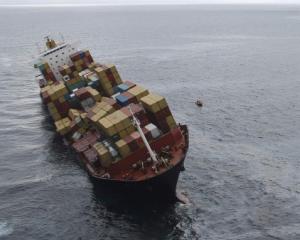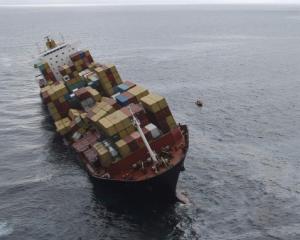Cargo around the wreck of a stricken cargo ship has broken up and contaminated the water surrounding the Astrolabe Reef off Tauranga.
Early indications from dive surveys have suggested that of the 36 remaining containers in the stern section carrying known contaminants, many have broken up and their contents have escaped since the vessel broke in two and sank, authorities said today.
Three containers, with cargo intact, were recovered; four were retrieved but were empty of contents; another seven were recovered in pieces; the contents of the remaining 22 are presumed lost to sea.
Sampling had confirmed there was elevated levels of contaminants close to the ship, which was wrecked after striking the reef on October 5, 2011.
Scientists were working to determine the significance of the contaminants, including any impact on marine life around the reef.
Professor Chris Battershill, University of Waikato Chair of Coastal Science, said it had been expected that contaminants would be found at the ship wreck site and they are now working directly with the salvors to access the reef to collect more samples.
"Sediment samples have shown elevated levels of contaminants including copper and PAH's (polyaromatic hydrocarbons) which are known contaminants that were lost to sea from the Rena and its cargo," he said.
"While we only have limited sampling information at this point, early indications are that the contamination is localised."
Bay of Plenty Medical Officer of Health Dr Jim Miller said while the two nautical mile exclusion zone remains in place, these results did not change current advice that there is no appreciable food safety risk from the Rena.
Resolve Salvage & Fire, appointed by the owners and insurers of the Rena are using specialist heavy-lifting equipment to remove cargo, wreck and container debris over approximately 10,000 square metres from around the wreck.
This work would enable scientists to undertake a more detailed study of the surface of the reef to help determine what if any contaminants remain trapped. Resolve will manage the removal of identified contaminants.
Professor Battershill said that the work is being carried out as quickly as possible but a full analysis would take time.
"We are working hard to get more information for the public as soon as we can. Once all the sampling, testing and analysis has taken place it is likely to be March when we will next be able to provide an update."
The ship split in two in early January last year and salvage operations before that had been unable to reach the containers as they were in the lower holds and inaccessible.
Of the 1368 containers carried on board at the time of the grounding, 1007 have been recovered.
Resolve is now using specialist heavy-lifting equipment to remove the large amounts of remaining cargo, wreck and container debris from an area approximately 10,000 square metres around the wreck.
More than 256 tonnes of debris has been removed in the last month.
Studies into the environmental, cultural, economic and safety impacts of the different options for dealing with the wreck were near complete.
A further round of community consultation will be held late next month, before a final decision is made
- Jamie Morton of the New Zealand Herald





